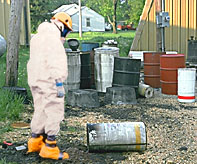
Highlights
EPA staff recently developed a model waste management plan framework for oil spills of national significance (SONS). Experience with major oil discharges has shown that many of the waste mgmt planning elements are similar and can be planned for ahead of time, which can then be tailored to the site-specific spill conditions at the time of a SONS. SONS Waste Mgmt Plan (PDF) (26 pp, 790KB)

EPA staff presented at the 2012 Wide Area Recovery and Resiliency Program (WARRP) Waste Management Workshop in Colorado to help state and local officials develop waste management plans for homeland security incidents. WARRP Summary Report and Presentations (PDF) (145 pp, 6.17 MB)
EPA's Homeland Security efforts include the management of wastes from Homeland Security incidents. These are incidents requiring a national response, such as acts of terrorism perpetrated with radiological dispersal devices or chemical or biological warfare agents; large-scale natural disasters, such as Hurricane Katrina; and animal disease outbreaks. This site provides waste management information that can be used by emergency planners, managers, and responders in planning before a homeland security incident occurs, and in decision-making during and after an incident.
- Basic Information
- Pre-Incident Planning and Preparation
- Considerations for Waste Management Decisions
- Waste Management Options
- Tools and Resources
- Frequent Questions
Incident Command System (ICS) As most incidents will generate waste, the Operations and Planning Sections of the ICS likely will have waste management-related responsibilities. Therefore, the ICS organizational structure may include, for example, a disposal group in the Operations Section or a disposal unit in the Planning Section. The information on the Web site, including considerations for waste management decisions, waste management options, and tools and resources, may help the ICS make waste management-related decisions during and after an incident occurs.
![[logo] US EPA](../gif/logo_epaseal.gif)